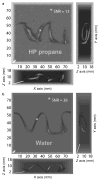High-resolution 3D proton MRI of hyperpolarized gas enabled by parahydrogen and Rh/TiO2 heterogeneous catalyst
- PMID: 24961814
- PMCID: PMC4288780
- DOI: 10.1002/chem.201403604
High-resolution 3D proton MRI of hyperpolarized gas enabled by parahydrogen and Rh/TiO2 heterogeneous catalyst
Abstract
Several supported metal catalysts were synthesized, characterized, and tested in heterogeneous hydrogenation of propene with parahydrogen to maximize nuclear spin hyperpolarization of propane gas using parahydrogen induced polarization (PHIP). The Rh/TiO2 catalyst with a metal particle size of 1.6 nm was found to be the most active and effective in the pairwise hydrogen addition and robust, demonstrating reproducible results with multiple hydrogenation experiments and stability for ≥1.5 years. 3D (1) H magnetic resonance imaging (MRI) of 1 % hyperpolarized flowing gas with microscale spatial resolution (625×625×625 μm(3) ) and large imaging matrix (128×128×32) was demonstrated by using a preclinical 4.7 T scanner and 17.4 s imaging scan time.
Keywords: heterogeneous catalysis; hyperpolarized gas; magnetic resonance imaging; parahydrogen; supported catalysts.
© 2014 WILEY-VCH Verlag GmbH & Co. KGaA, Weinheim.
Figures


Similar articles
-
Heterogeneous Parahydrogen Pairwise Addition to Cyclopropane.Chemphyschem. 2018 Oct 19;19(20):2621-2626. doi: 10.1002/cphc.201800690. Epub 2018 Aug 7. Chemphyschem. 2018. PMID: 30039565 Free PMC article.
-
Parahydrogen-Hyperpolarized Propane-d6 Gas Contrast Agent: T1 Relaxation Dynamics and Pilot Millimeter-Scale Ventilation MRI.J Phys Chem A. 2025 May 15;129(19):4275-4287. doi: 10.1021/acs.jpca.4c08800. Epub 2025 May 1. J Phys Chem A. 2025. PMID: 40311080
-
Demonstration of heterogeneous parahydrogen induced polarization using hyperpolarized agent migration from dissolved Rh(I) complex to gas phase.Anal Chem. 2014 Jul 1;86(13):6192-6. doi: 10.1021/ac5013859. Epub 2014 Jun 11. Anal Chem. 2014. PMID: 24918975 Free PMC article.
-
Parahydrogen-Induced Hyperpolarization of Gases.Angew Chem Int Ed Engl. 2020 Oct 5;59(41):17788-17797. doi: 10.1002/anie.201915306. Epub 2020 Aug 11. Angew Chem Int Ed Engl. 2020. PMID: 31972061 Free PMC article. Review.
-
Bridging the Gap: From Homogeneous to Heterogeneous Parahydrogen-induced Hyperpolarization and Beyond.Chemphyschem. 2021 Apr 19;22(8):710-715. doi: 10.1002/cphc.202001031. Epub 2021 Apr 6. Chemphyschem. 2021. PMID: 33825286 Free PMC article. Review.
Cited by
-
Toward Production of Pure 13C Hyperpolarized Metabolites Using Heterogeneous Parahydrogen-Induced Polarization of Ethyl[1-13C]acetate.RSC Adv. 2016;6(74):69728-69732. doi: 10.1039/C6RA15808K. Epub 2016 Jul 15. RSC Adv. 2016. PMID: 28042472 Free PMC article.
-
Heterogeneous Parahydrogen Pairwise Addition to Cyclopropane.Chemphyschem. 2018 Oct 19;19(20):2621-2626. doi: 10.1002/cphc.201800690. Epub 2018 Aug 7. Chemphyschem. 2018. PMID: 30039565 Free PMC article.
-
Recent advances in the application of parahydrogen in catalysis and biochemistry.RSC Adv. 2022 Apr 26;12(20):12477-12506. doi: 10.1039/d2ra01346k. eCollection 2022 Apr 22. RSC Adv. 2022. PMID: 35480380 Free PMC article. Review.
-
NMR Spin-Lock Induced Crossing (SLIC) dispersion and long-lived spin states of gaseous propane at low magnetic field (0.05T).J Magn Reson. 2017 Mar;276:78-85. doi: 10.1016/j.jmr.2017.01.014. Epub 2017 Jan 21. J Magn Reson. 2017. PMID: 28152435 Free PMC article.
-
Heterogeneous Microtesla SABRE Enhancement of 15 N NMR Signals.Angew Chem Int Ed Engl. 2017 Aug 21;56(35):10433-10437. doi: 10.1002/anie.201705014. Epub 2017 Jul 28. Angew Chem Int Ed Engl. 2017. PMID: 28644918 Free PMC article.
References
-
- Nelson SJ, Kurhanewicz J, Vigneron DB, Larson PEZ, Harzstark AL, Ferrone M, van Criekinge M, Chang JW, Bok R, Park I, Reed G, Carvajal L, Small EJ, Munster P, Weinberg VK, Ardenkjaer-Larsen JH, Chen AP, Hurd RE, Odegardstuen LI, Robb FJ, Tropp J, Murray JA. Sci Transl Med. 2013;5:198ra108. - PMC - PubMed
-
- Goodson BM. J Magn Reson. 2002;155:157–216. - PubMed
Publication types
MeSH terms
Substances
Grants and funding
LinkOut - more resources
Full Text Sources
Other Literature Sources
Medical
Miscellaneous

